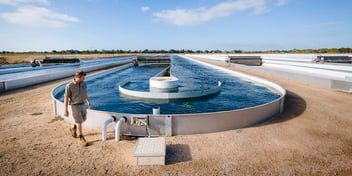Weed-spraying robot to keep herbicides away from the Great Barrier Reef
Herbicide runoff from the Great Barrier Reef (GBR) catchment is a serious threat to plants and animals in both coastal and inshore waterways, but a smart weed-spraying robot is set to help reduce herbicide usage on sugarcane farms by at least 80%.
Collaborating with AutoWeed and Sugar Research Australia, James Cook University will oversee the development of the new technology, which will be funded by a $400,000 grant through a partnership between the Great Barrier Reef Foundation and the Australian Government’s Reef Trust.
AutoWeed — a start-up agricultural technology company developing smart spot-spraying systems — will provide the technology, while Sugar Research Australia will help assess the water quality improvements as a result of the technology’s application.
James Cook University (JCU) senior engineering lecturer Dr Mostafa Rahimi Azghadi said the project will be bolstered by "deep learning" technology being developed by JCU and AutoWeed, which is used to detect and spray priority sugarcane weeds.
“Most herbicides, being mobile in soil, are carried in river runoff and have been detected in GBR ecosystems at concentrations high enough to affect organisms,” he said.
“Sugarcane farms are only 1.4% of the GBR catchment area, but contribute 95% of the pesticide load draining to the GBR.”
AutoWeed co-founder and engineer Jake Wood said the new system uses stored images to identify priority weeds and spray them without hitting non-target crops, helping to reduce spraying costs and mitigate unnecessary herbicide application.
“Extending our AutoWeed spot spraying technology to sugarcane requires significant new research and development. We aim to reduce knockdown herbicide usage on sugarcane farms by at least 80%,” he said.
“This will incentivise water quality improvements in reef catchment areas by reducing weed management costs for farmers while also lowering the concentration of herbicides in runoff to support a healthy reef.”
Crop categorisation
The first year of the project will focus on collecting hundreds of thousands of images of sugarcane farmers’ crops. The images will be labelled by a human expert and fed into deep learning models to train the weed and crop detection system, improving detection performance over time.
Azghadi said the second year will focus on developing and trialling the herbicide delivery component of the project.
“We’re aiming to design, develop, and trial the spot spraying method and fit it to a 24-metre wide, high-rise self-propelled boom to be used on a sugarcane farm,” he said.
Wood said the technology had previously targeted weeds in cattle pastures and broadacre crops, but sugarcane presents a new application of the technology.
“The project will use deep convolutional neural networks — the very same used by Facebook to detect faces and Google to optimise image searches — but it will be the first time it’s been applied to sugarcane,” he said.
Great Barrier Reef Foundation Managing Director Anna Marsden said land-based runoff is a significant threat to water quality and the health of the GBR.
“Sediment and pollutants running into the Reef’s waters smother coral and seagrass, are toxic to marine life and contribute to crown-of-thorns starfish outbreaks, and we must continue to work together and do better,” Marsden said.
“We know that there is a high calibre of work being undertaken by farmers and the agricultural community to safeguard the future of the reef, however, if we are to reach the targets set out by the Reef 2050 Water Quality Improvement Plan then we need to stimulate new ideas and out of the box solutions.
“This innovative project will add to the more than 60 reef-saving projects we are delivering right now with over 65 project delivery partners.”
The two-year project is expected to run until August 2022.


